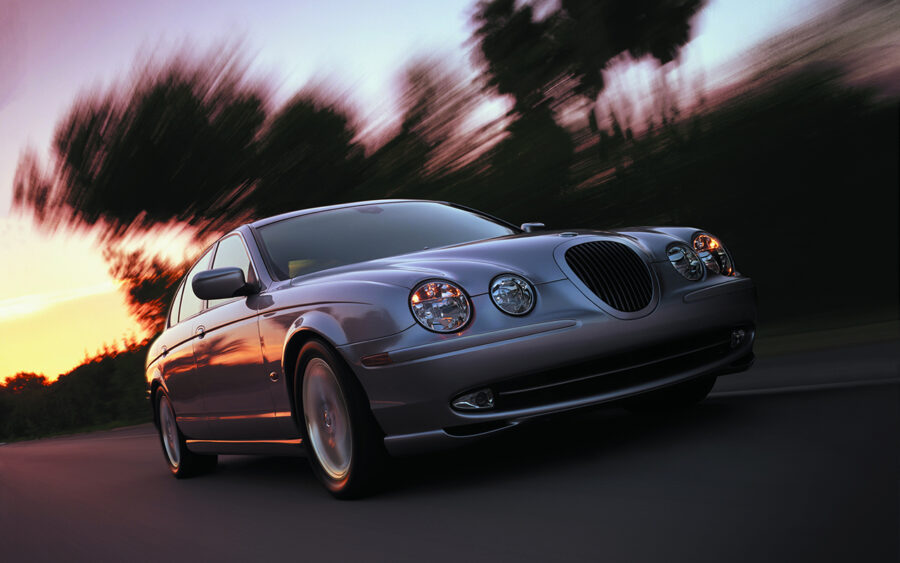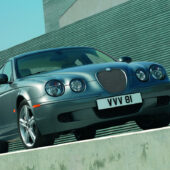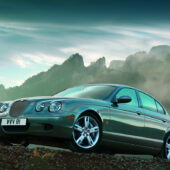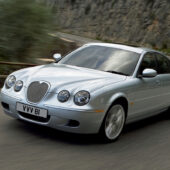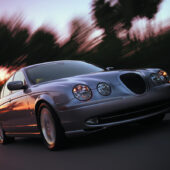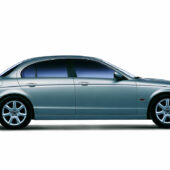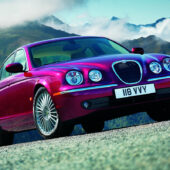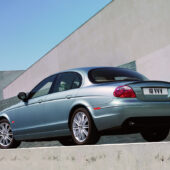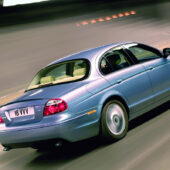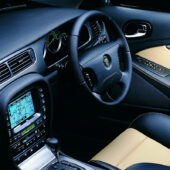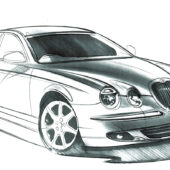Under Ford control, Jaguar created a sub-XJ saloon fit for the 21st century yet unashamedly retro in its design: the Jaguar S-Type
Words: Paul Wager
With the previous XJ40 being usurped by a new generation of XJ saloon in 1994, and the long-running XJS finally giving way to the all-important XK8 two years later, Ford had successfully reinvented Jaguar’s two-car model range. Its longer-term focus, however, was on chasing extra volume, something that could only really occur via an expanded line-up. And so, with an eye on the success of BMW, Ford management reasoned quite logically that the brand needed a smaller, more affordable car to sit below the XJ and challenge the all-conquering BMW 5 Series.
The end result was the S-Type, which not only took its name from the Mk2-derived saloon of the ’60s but was also unashamedly influenced by Jaguar styling from the same decade. The chrome oval grille and drooping rear were a neat piece of work if the goal was to evoke the Mk2; and in fairness to Jaguar, the retro look was becoming popular, which helps explain both the Rover 75 and VW’s New Beetle. Against the crisply styled Audi, BMW and Mercedes-Benz products of the time though, Geoff Lawson’s retro styling limited the Jaguar’s appeal among the more youthful buyers Ford might have been hoping to entice into the brand.
It became glaringly obvious that Ford’s US-based top brass had misjudged the European market. And that was something of a shame, since under the curves and chrome of the S-Type was a deeply impressive car that on purely technical grounds stood up to the German competition without making any excuses.
The S-Type’s styling would be toned down over time, and when it finally ceased production in 2007 it had played a major role in helping to lift Jaguar’s annual sales above 100,000 for the first time. A further measure of its success is that the platform was deemed modern enough to form the basis of the 2008-model XF, the S-Type’s successor – and a car about as far from retro as it could be.
Plans for a smaller Jaguar model had been in the works for some time but official confirmation came in July 1995 when Ford announced that it was investing £500m in its Castle Bromwich plant. Work on the car itself had begun in the spring of that year, although as Nick Hull relates in his title Jaguar Design, preliminary sketches had been started in late 1994.
No fewer than five full-size clay models had been produced by May 1995, but in terms of the engineering, the basics still needed to be finalised. Even the mighty Ford Motor Company would have baulked at the idea of funding an all-new platform for such a low-volume (by ‘Blue Oval’ standards) model, and so the solution was to use the DEW98 platform that was then in development for the Lincoln LS and Ford Thunderbird. Crucially, this was engineered for rear-wheel drive.
The popular misconception is that Jaguar was simply handed the Lincoln floorpan and told to add some wood and leather, but the reality is rather different. As Hull relates, engineers from Ford were based at Jaguar’s Whitley development centre in Coventry, while Jaguar engineers also went over to Dearborn. The introduction of networked computer systems meant that further collaboration could be continued remotely, and the result was that the platform was much more of a collaborative development than many realise.
As Hull relates, the differences between the Lincoln and the Jaguar were mainly in the outer skin of the body-in-white, but the Jaguar engineers were able to influence the so-called hard points of the design. The result was a lower ‘hip point’ (a term denoting the height of the front seat cushion), revised crash structure and a shorter front overhang. Ford engineers were as keen to access the Jaguar engineers’ ride and handling expertise as the Coventry teams were to utilise Ford’s resources.

Back in 1999, the industry journal Design News quoted Jaguar’s then chief programme engineer for the car as explaining that the idea was to develop the high-cost items like crash safety, suspension layout, fuel systems, transmissions and climate control in common to achieve worthwhile cost savings, then endow each model with different ride and handling characters to suit their target markets.
Underneath, the rear suspension was by unequal-length wishbones in Jaguar tradition, but the S-Type abandoned the XJ’s practice of using the driveshaft as the upper link, employing instead a cast aluminium wishbone together with a fifth link to control toe angle. The wishbones, differential and anti-roll bar were all mounted on an aluminium subframe in order to insulate noise, vibration and harshness (NVH) from the interior. At the front end, meanwhile, the S-Type’s suspension used a Honda-style combination of wishbones and strut, with the lower wishbone mountings also carried on a separate aluminium subframe. Speed-dependent variable power steering assistance was also added, alongside modern electronic measures including traction control, electronic brake-force distribution and optional stability control.
The car’s electrical architecture used multiplexed wiring like its German competitors – essentially comprising a low-voltage data bus system to communicate between various control modules using only a single twisted pair of wires, reducing the weight and complexity of a traditional wiring loom. At launch, the S-Type was offered with two powerplants: Jaguar’s AJ-V8 (already found in the XK8 and XJ8), plus a 3.0-litre V6 derived from Ford’s Duratec unit.
The S-Type made its debut at the British International Motor Show of October 1998, although it didn’t officially go on sale until the following March. Just three models were offered initially, a range that comprised the 3.0 V6 in standard or Special Equipment (SE) trim and the 4.0 V8. In December 2000, however, at the Bologna Motor Show, a Sport trim level was added, offering colour-coded exterior, grey veneer inside, stability control and 18-inch ‘Monaco’ wheels; the newcomer was available with either V6 or V8 power, with the latter featuring the adaptive CATS suspension as standard. Unlike the V8 engine, the V6 powerplants were more Ford and less Jaguar. Based extensively on the all-aluminium Duratec family of modular 60-degree V6 engines, which first appeared in the Mondeo in 1993, they received Jaguar-developed cylinder heads, intake manifolds and one-piece camshaft, together with the split-fracture con rods similar to the V8 and direct-acting mechanical tappets. In the process, the 3.0-litre version gained a best-in-class specific output, beating BMW at its own game.
March 2002 saw the V8 being enlarged to 4.2 litres, while a 2.5-litre version of the V6 was also added to the range. The introduction of the enlarged V8, however, coincided with the launch of the S-Type R, which belied the retro styling with a formidable 390bhp (later 400bhp) punch that took the fight to BMW’s identically powered M5. In truth, the character of the two cars was very different, but the Jaguar was a credible contender and was seen as the better package by many. Praise indeed, in the face of BMW’s famed ‘M’ division.

The new engine line-up also coincided with a minor facelift for the 2003 model year, which added a revised dashboard and centre console with electronic parking brake, while externally there was a redesigned front grille incorporating the Jaguar badge. Other mechanical changes, meanwhile, included the replacement of the Ford five-speed automatic with a six-speed ZF unit, while the 3.0 V6 engine was uprated to 235bhp and the ignition now used a flip key.
A more extensive facelift under the direction of Ian Callum arrived in April 2004 for the ’05 model year, involving restyled front and rear valances, a revised grille, reshaped rear lamps and a reshaped aluminium bonnet without washer jets, which were now incorporated into the wipers. At this point, Jaguar also finally bowed to the inevitable and added a diesel to the range in the form of the 2.7-litre AJD-V6 unit co-developed with PSA – a smooth and torquey unit that suited the car very well, despite reliability issues that would surface later on. A twin-turbocharged, 32-valve twin-cam V6, the common-rail injected unit used an iron block with aluminium heads and was technically a member of Ford’s Duratorq engine family. In Jaguar applications, the unit was twin-turbocharged in the interests of a flatter power curve. It was developed and produced at Ford’s Dagenham facility and would go on to power the XF, as well as the X350-generation XJ models before being superseded by a 3.0-litre version.
The Jaguar S-Type wasn’t built at the firm’s traditional Browns Lane home, which lacked sufficient capacity for Ford’s planned volumes, but at Castle Bromwich in nearby Birmingham. Established as a shadow factory during the Second World War, when it was involved in Spitfire and Lancaster production, the plant eventually ended up in the hands of British Leyland.
Whilst under the control of Pressed Steel, Castle Bromwich provided bodyshells and pressings for use throughout the BL empire. Its clients included Jaguar, with painted XJ shells being trucked to Brown Lane for assembly – but as John Egan recounts, it wasn’t a happy relationship. Quality was dire and bodies needed much hand-refinishing, and so Egan eventually offered to take the entire plant (by then vastly underutilised) under Jaguar control.
When Ford arrived, its ambitious plans for increased volume simply couldn’t be met by the Browns Lane facility, and so the Castle Bromwich plant provided the ideal solution. After a significant investment, the inaugural S-Types to roll off the production line in late 1998 represented the first complete vehicles to be built at the plant since the final Spitfire in 1945. By the time the S-Type finally bowed out, replaced by the XF, some 295,000 examples had been built.
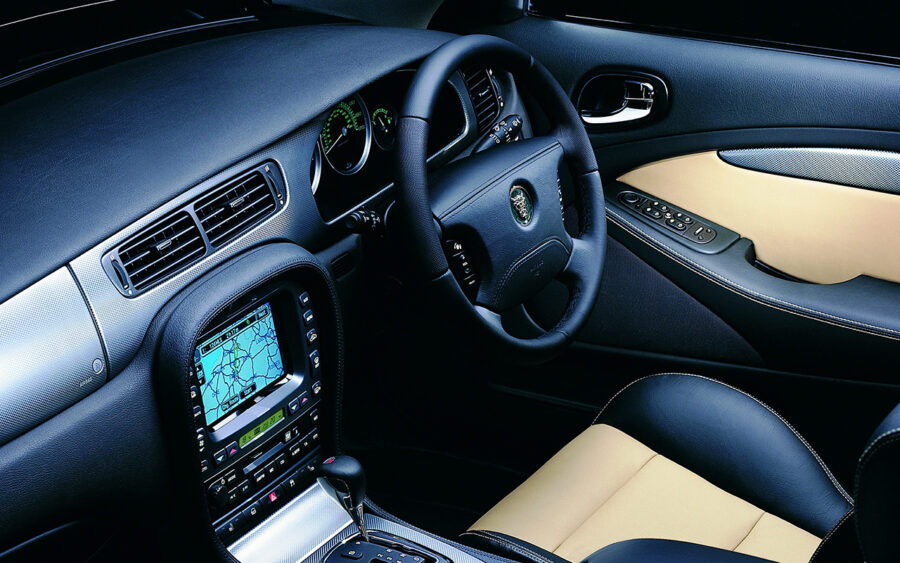
Jaguar S-Type timeline
1995
Original designs penned by Jaguar designer Geoff Lawson (of XJ220 and X-Type fame)
1998
S-Type shown at the Birmingham International Motor Show in October
1999
Sales of X200-generation S-Type begin in January
2002
X202-generation facelift arrives
Supercharged S-Type R introducted with 400hp
2004
X204-generation facelift introduced, bringing a diesel option for the first time
2006
X206-generation facelift arrives
2007
Jaguar S-Type goes off sale, replaced by Jaguar XF (X250)

